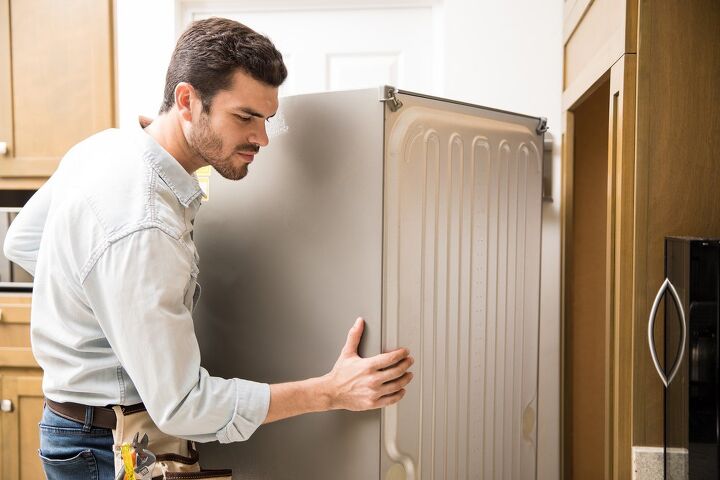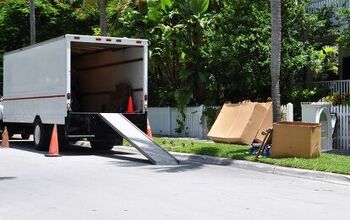Why Does My Refrigerator Water Line Keep Freezing? (Fix It Now!)

It’s hard to imagine life without the modern conveniences built into today’s refrigerators. Automatic ice makers and water dispensers are quicker than cracking ice cube trays and faucets, and often taste cleaner. When these features stop working, it can be annoying and frustrating to pinpoint the reason for the breakdown
Often, the cause stems from the refrigerator water lines freezing over and preventing proper water flow. This often happens if the freezer is getting excessively cold or if the door insulation is not fully shielding the water line. Adjusting the freezer temperature and ensuring that the water line is clear should correct the problem.
Freezing water lines tend to occur most often in side-by-side refrigerator models. However, stacked and French door models are susceptible as well, particularly if the doors stay open longer than necessary. Preventing outside moisture conditions is a start, but you’ll also need to know how to improve water line flow.
Do You Need Appliance Repair Services?
Get free, zero-commitment quotes from pro contractors near you.

What Does the Refrigerator Water Line Do?
The ice maker and water dispenser need a water source in order to operate. The refrigerator typically connects to the kitchen feed pipe, which sources your sink and dishwasher. So you’ll need some pathway to move the water from the home’s main line into the refrigerator.
The refrigerator water line is a long flexible hose usually made of PVC or braided wire. It has a connector much like the water lines that feed the kitchen faucet that connects to the main supply. Once you install the water line, the refrigerator has its own dedicated flow line into the appliance.
The internal line tubing connects the larger line’s water flow to the ice maker and water dispenser. It is thinner than the refrigerator water line and is typically made of copper or plastic. Copper is sturdier and lasts longer but prone to dent on impact, while plastic is more flexible yet less durable.
What Might Cause a Freezing Refrigerator Water Line?
In order to allow smooth water flow, the refrigerator line itself needs to maintain a constant optimal temperature. The water line has to be warm enough to keep the water flow from freezing over before it gets to its destination. If the water line temperature gets too low, the water inside will begin to freeze and stop flowing.
The less expensive PVC line, while economical, has the poorest insulation properties and is more prone to freezing over. The more protection the line itself gives, the less likely that it will freeze over. Choosing the braided water line may cost a little more upfront but will last longer and work more efficiently.
Even the best water line is susceptible to repeated exposure to extreme cold or outside moisture. Monitor your appliance’s temperature to ensure it doesn’t dip too far below an ideal temperature. And your parents were right: hanging inside the open fridge lets in warm air and moisture that can freeze lines.
How Do I Correct a Frozen Refrigerator Water Line?
You’ll need to figure out why the line is freezing over: is it too much cold or too much moisture? You can easily check the temperature by placing a thermometer between packages inside. If the temperature is lower than ideal, raising the thermostat can correct the problem quickly.
If too much moisture has gotten to the water line, check the door insulation for gaps and imperfections. You’ll definitely need to close any air gaps for the refrigerator to work efficiently. Before you take care of that, you may need to thaw out a frozen line.
First, you have to locate your water lines outside and inside the refrigerator. Next, you’ll need to determine what degree your water line is frozen over. Whether it’s your entire main line or the flow to the ice maker or water dispenser dictates how to proceed.
Step 1: Unplug the Refrigerator and Prepare for Leaks
With any repair, however minor, the safest thing to do first is to unplug the appliance to reduce electrocution risks. Water and electricity are a dangerous combination, and you want to protect both yourself and your appliance. It’s a good idea to put towels on the floor to absorb any water line leaks.
Ideally, you’ll test your water and ice dispensers before unplugging to ensure that nothing is coming out. Most water dispensers have a manual switch you can still push even when the refrigerator is unplugged. This will be instrumental in finding which line is leaking.
Step 2: Test to See If the Line Is Frozen
Unscrew the main line connectors first and press the dispenser lever; replace connectors if the water flows. Once that’s confirmed, remove the kick plate at the refrigerator bottom and unhook the water line just under the door. Place a container under the water dispenser line, then manually push the lever to see if water flows out.
If you get water flow, the water line likely froze inside the door. You can reconnect the water line and replace the kick plate before moving to the inside of the door. Then you’ll need to access the frozen portion of the water line to thaw it out.
Step 3: Thaw the Frozen Line
The quickest, handiest method to thawing your water line is using a heat gun or a hairdryer. Using the dryer on high heat, wave across the water line, dispenser control panel, and the back of the door. Check after about 15 minutes to see if the lines are clear.
There’s another little tool called the Water Line Buddy that may work more efficiently. The Water Line Buddy is a small syringe that can shoot hot water into the dispenser line from the outside. The hot water will thaw any internal blockage and restore water flow in a few minutes.
The major plus for the Water Line Buddy is that you don’t necessarily have to unplug the refrigerator to use it. Nevertheless, you can still unplug the fridge, and the Water Line Buddy will work just the same. You can remove the wet towels and plug in the refrigerator once you’re sure the water lines are clear.
Step 4: Protection and Prevention
Once the water lines are running clear again, you’ll need to eliminate the conditions that caused the lines to freeze. You should check your gasket seals and the water line insulation for gaps. Also, you might need to take additional measures to prevent the problem from recurring.
You can install a simple water line heater that clips into the control panel wiring and maintains line water temperature. You should also check your dispenser door flap for warping or deformities; air and moisture could be entering through here. Replacing the water filter or water valve may be last resort fixes if either is slowing or stopping water flow.
These fixes will, of course, depend on the manufacturer and model of your appliance. Additionally, these basic fixes may not fully solve the problem with simple home fixes. You’ll need to place a service call to a professional at this point.
Do You Need Appliance Repair Services?
Get free, zero-commitment quotes from pro contractors near you.

Related Questions
How do I fix low water pressure in my refrigerator?
Lower water pressure in the refrigerator depends on several factors, including the model itself. Manufacturers build their appliances and operating system in vastly different ways. There are some basic areas you can check regardless of the model to help adjust low water pressure.Most, if not all, new refrigerators with dispensing features have water filters installed. These filters typically fill up with debris and impurities and need replacing every six months. Simply replacing an old refrigerator water filter can improve water pressure.Other possible reasons for low water pressure include kinked or pinched water supply lines or a whole-house filtration system. You may need to move your appliance and physically straighten the supply line–or replace it if it’s damaged. Bypassing a whole-house filtration system with a dedicated line or a bypass cartridge can also help boost dispenser water pressure.
How do I clean my refrigerator water line?
Water impurities flow into the refrigerator’s water filter, and calcium and bacteria can build up in water lines. Since you’ll be drinking and cooking with this water, you’ll want to include cleaning in your water line maintenance routine. Ideally, you’ll want to do this every six to 12 months to maintain water quality.Turn off the water supply to the cooling system, then pour some distilled vinegar down the tube. It’s a good idea to flush the ice maker system as well, so be sure to include that line. A bottle brush that fits the tubing and water spout will help the vinegar give a deeper clean.Once done, flush the vinegar thoroughly from the system and turn on the water supply. Run the water and ice maker through a few cycles to make sure the lines are completely flushed. It’s wise to also remove the ice tray and soak it in soapy water, thoroughly rinsing before reinstalling.
How often should you replace the refrigerator water line?
Proper cleaning and maintenance will help prolong water line life, but eventually, you’ll need to replace it. Experts recommend you examine the line regularly for blistering, stress cracks, and loose connections, replacing every five years. Using higher quality materials like steel-braided lines and copper tubing can extend material life and appliance functionality.

Stacy Randall is a wife, mother, and freelance writer from NOLA that has always had a love for DIY projects, home organization, and making spaces beautiful. Together with her husband, she has been spending the last several years lovingly renovating her grandparent's former home, making it their own and learning a lot about life along the way.
More by Stacy Randall











![How Much Weight Can a 4×4 Support Horizontally? [It Depends!]](https://cdn-fastly.upgradedhome.com/media/2023/07/31/9070333/how-much-weight-can-a-44-support-horizontally-it-depends.jpg?size=350x220)















